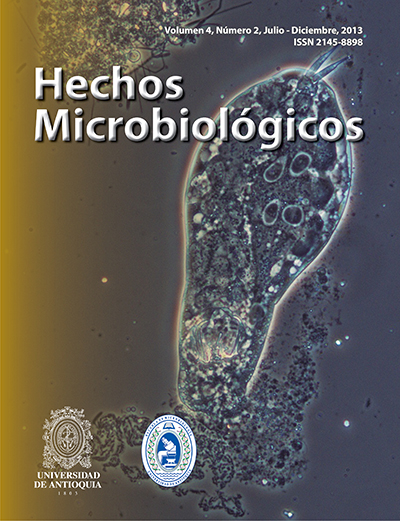Bioethanol production employing traditional and extractive fermentation from fique juice
DOI:
https://doi.org/10.17533/udea.hm.21090Keywords:
bioethanol, fique juice, alcoholic fermentation, extractive fermentationAbstract
Downloads
References
Siqueira P, et al. Production of bio-ethanol from soybean molasses by Saccharomyces cerevisiae at La-boratory, pilot and industrial scales. En: Bioresource Technology. Vol. 99, No.17. 2008; p. 8156-63.
Cheng H, Wang F. Optimal process/solvent design for ethanol extractive fermentation with cell re-cycling. En: Biochemical Engineering Journal. Vol.41, No.3. 2008; p. 258-65.
Murray D. El potencial del etanol: mirando más allá del maíz 2005 http://www.terra.org/arti-culos/art01335.html
Ministerio de Ambiente.Guía ambiental del sub-sector fiquero. 2a Ed. Bogotá (Colombia). 2006; 128 p.
Karunanidhi, Anuradha. Extractive Fermentation of Ethanol in an aqueous two-phase system bySaccharomyces cerevisiae NCIM 3288. Advanced Bio-tech, Vol. 11. 2008; p.11-5.
Boudreau T, Hill G.Improved Ethanol-water separa-tion using fatty acids. En: Process Biochemistry 41; 2006.
Rivera E, et al.Evaluation of optimization techni-ques for parameter estimation: Application to etha-nol fermentation considering the effect of tempera-ture. En: Process Biochemistry 41. 2006; p.1682-7.
APHA. Standard methods for the examination of wa-ter and wastewater. 20th ed. Washington DC: Ameri-can Public Health Association. 1998.
Pretorius I, et al.Designer Yeasts for the Fermenta-tion Industry of the 21st Century. En: Food Technol. Biotechnol. 2003; 41(1). p.3-10.
Lloret S, Carmina, Gutiérrez U, Olivia, Borrell S, Nuria. Candida lusitaniae. http://www.seimc.org
González A, Valenzuela L.Saccharomyces Cerevi-siae. México http://www.microbiologia org.mx/microbiosenlinea/CAPITULO_20/Capit-ulo20.pdf.
Sánchez O, Cardona.Producción biotecnológica de alcohol carburante I: A partir de diferentes materias primas. En: Interciencia. 2005; p. 671-7.
Conrad J, et al. A novel furostanol saponin from Tríbulus terrestris of Bulgarian origin. In: Fitoterapia, Vol.75, No.18. 2004.
Sliwinski B, et al.Efficacy of plant extracts rich in secondary constituents to modify rumen fermen-tation. In: Animal Feed Science and Technology, Vol.101, No. 23. 2002.
Jeffries TW, Alexander MA.Production of ethanol from xylose by Candida shehatae grown under con-tinuos or fed-batch conditions. En: Biotechnology in pulp and paper manufacture. http://www.fpl.-fs.fed.us/documnts/pdf1990/jeffr90a.pdf. .
Freer S, Greene R.Transport of Glucose and cello-biose by Candida wickerhamii and Clavispora lusita-niae. The Journal of Biological Chemistry, Vol. 265, No. 22, August 5, 1990, p.12865.
Treybal R. Operaciones de transferencia de masa, 2aEd. Mc Graw-Hill, México 1988; 858 p.
Offeman R, et al.Extraction of ethanol with higher alcohol solvents and their toxicity to yeast. Separation and Purification Technology 63. 2008; p. 444-451.
Kutluo O, et al.Bioconversion of starch into etha-nol by a recombinant Saccharomyces cerevisiae stra-in YPG-AB. En: Process Biochemestry. Vol.37, No.10. 2002; p.1157-68.
Linde M, Galbe M, Zacchi G.Simultaneous saccha-rification and fermentation of steampretreated barley Straw at low enzyme loadings and low yeast concen-tration. En: Enzyme and Microbial Technology. Vol.40, No.5. 2007; p.1100-7.








